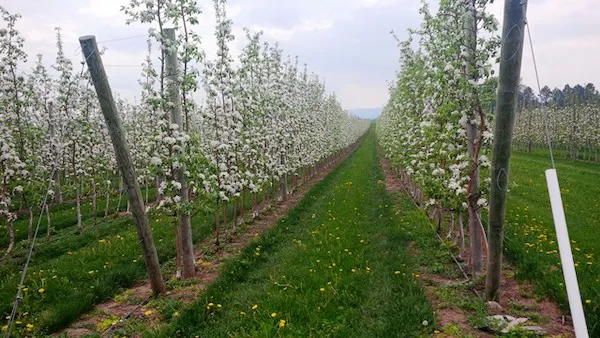In a monthly feature, Craig Stauffer of Vanguard International writes about an industry topic. This month, Vanguard sheds light on how COVID-19 is impacting the fresh produce industry, with labor shortage pressure on growers feeling even more prominent than usual. Stauffers's feature is below:
"The conversation about automation on the farm is one we are not unfamiliar with. Growing fresh produce demands an extensive manual labor force that has always been a difficult order to fill. Although, with the emergence of a global pandemic and borders shutting down worldwide, is it ever top-of-mind even more so now. COVID-19 has presented a whole new set of labor challenges.
 Most farm work can be attributed to laborers who travel from outside a nation’s own borders. This very important labor is required year-round for a variety of pre- and post-harvest activities, including pruning, spraying, picking, packing, and storage. These jobs are often physically strenuous and span 6-7 days a week during peak harvest periods. If a crop is ready to harvest, the crop does not take the weekend off. This is one of the reasons it is a struggle to find homegrown residents during normal times that are interested in this type of work when the pay grade is typically at, or slightly above, minimum wage. For the Northern Hemisphere, demand for manual labor becomes most intensive during harvest in the spring and summer, and demand continues in the South Hemisphere when summer arrives there in the counter-season.
Most farm work can be attributed to laborers who travel from outside a nation’s own borders. This very important labor is required year-round for a variety of pre- and post-harvest activities, including pruning, spraying, picking, packing, and storage. These jobs are often physically strenuous and span 6-7 days a week during peak harvest periods. If a crop is ready to harvest, the crop does not take the weekend off. This is one of the reasons it is a struggle to find homegrown residents during normal times that are interested in this type of work when the pay grade is typically at, or slightly above, minimum wage. For the Northern Hemisphere, demand for manual labor becomes most intensive during harvest in the spring and summer, and demand continues in the South Hemisphere when summer arrives there in the counter-season.
How COVID-19 creates further labor challenges
Over the past four months, governments worldwide began shutting down borders amid the pandemic, and uncertainty over labor ensued. Every grower is struggling with the new, almost weekly, changes to the rules around migrant labor, thus impacting accessibility to laborer’s who have often been with a grower for decades. Growers everywhere are lobbying their respective governments to mediate this issue and to develop new guest worker programs. Now, with stricter measures in place to ensure the safety of both the country and produce, growers will likely need to adhere to new imposed standards such as:
- Quarantining migrant workers in physical-distanced housing for fourteen days upon entry into the country.
- Ensuring physical distancing for workers while in the fields and orchards, reducing capacity.
- Installing plexi-glass and other distancing measures in offices and on packing lines, reducing the pace of output and negatively impacting efficiencies.
These new standards will be costly and challenging to implement. A first instinct might be to call out to domestic residents who have lost their jobs as a result of COVID-19, to request help on their nation’s farms. New Zealand’s own residents responded very positively to this strategy, and many signed up to help. However, we are not seeing this happen in many other countries because government relief packages for the unemployed are far too attractive to residents, making the idea of getting their hands dirty with minimum wage work appear undesirable.
CGTN speaks to Luis Munoz, who runs Working Link, a Mexico City agency which finds seasonal work for Mexican economic migrants for the United States, and he quotes, '…historically, the jobs done by Mexicans are precisely the jobs the U.S. citizens don't want,' Munoz said. 'In my experience, they don't accept the difficulty of the work, and end up quitting, as it's easier for them to fall back on unemployment benefits or social security payments offered to them by their government.'
According to The New York Times, this concern is widespread, 'In Britain, farmers are struggling to find people to pick raspberries and potatoes. Part of Germany’s prized white asparagus crop risks rotting in the ground. And in Italy, over a quarter of the strawberries, beans, and lettuce ripening in the coming months may lack harvesters.'
Coldiretti, Italy’s biggest agriculture association, reports that about a quarter of Italian food products are gathered by 370,000 foreign seasonal workers, mainly from Eastern Europe. According to the same New York Times article on this issue, 'The country needs at least 50,000 workers through spring. Around 2,000 people have applied to substitute for the seasonal workers. To attract more, Coldiretti says, the government must modify wage conditions to make it easier for students, retirees, or the unemployed to receive pay while working in the fields.'
You can see why growers are facing concerns. What’s more, even if you find resident workers, people must be trained and have endurance to uproot vegetables, pluck strawberries, or harvest peaches quickly and in large quantities without damage. Who is paying for this training? Growers are.
What is happening as a result?
Growers are left with reduced labor to harvest crops this summer. In some cases, this will get resolved, but in others, by the time a resolution is found it will be too late for their crops. Without labor, the fruit cannot even be picked for donation to foodbanks, let alone sold normally. Crops such as lettuce or strawberries, are particularly labor-intensive and shortages impact these growers very hard. As a last resort, a grower may be forced to disc-up ground crops into the soil to become mulch to avoid growth of mold spores that could harm future seasons.
This is where automation on the farm becomes top-of-mind. It has become increasingly apparent that a reliance on migrant labor is not ideal.
Growers are asking themselves, 'What can I digitize? What can I automate?'
There have been numerous experimental technologies that have emerged in the last decade to assist the fresh produce industry improve harvest and packing operations. The first to succeed has been improvements in capacity and speed in packing fruit and improving the quality of pack outs. Cherries, for instance, are a fruit that can be sold with a conversation categorized by what automation technology they use. One being Unitec that detects defects both inside and outside of cherries, aligns with quality standards or market needs for different varieties, and sorts accordingly. A similar example for citrus is called Smart Grader. Whether it is determined graphically, or by commodity, there always seems to be a favorite. And, it’s different in Germany than in South Africa, and for citrus versus cherries.
It does not stop here though. Experiments in automation for farming are continuously making headway. Apple growers have been experimenting with growing fruit on walls. According to Hugh Fraser, Agricultural Engineer with the Ontario Ministry of Agriculture, Food and Rural Affairs (OMAFRA), more uniform trees will give growers the option of mechanizing more of the apple growing process, such as using harvest platforms to pick fruit, or GPS-guided equipment in the orchard. He quotes, “Labor is getting more difficult to find and afford, so if we can make tasks in the orchard more similar, easier, and repeatable, we can use more mechanization or even robotic picking or pruning in the future.”
 Photo from Ontario Apple Growers
Photo from Ontario Apple Growers
This video created by CNBC covers Sweeper technology, an AI robot that picks vegetables in greenhouses. For example, with computer vision, Sweeper determines if a pepper is ripe, and uses a razor to cut off the stem. It takes Sweeper 24-seconds to pick a single pepper, and it can work 20 hours per day. So far, it is 61% accurate in picking ripe fruit. Similar robots are being created and tested to pick strawberries, tomatoes, and more.
There is even a company now creating software that acts as a plug-in to farming equipment, such as a tractor, that turns it into a self-driving autonomous machine. Picture a 100-acre lot being farmed with tractors with no people on them. Wild stuff!
Of course, there are many hiccups that come into play. A machine has to be gentle enough when picking that it does not ruin the fruit and it has to be sound enough to pass safety standards. But all in all, I believe our industry’s movement towards automation is incredibly positive. Experts say that the agricultural robot industry will reach $75 billion in 2025, and I would not be surprised if this holds true.
The goal with automation in farming is to replace jobs that are onerous and undesirable across the board. Although expensive, when implemented accurately, they can have enormously positive returns on investment for growers, and at the end of the day, can help solve the growing problem of farm labor shortages around the world."
 For more information:
For more information:
Rebecca Cumming
Tel: +1 (226) 456-3141
Email: rebecca@blitzme.ca
www.vanguardteam.com
